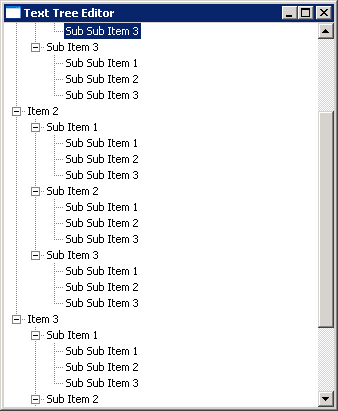- You can also associate the editor with a button to launch a dialog box for editing tree nodes.
- You create the editor and control just like you do with the other editor classes.

import org.eclipse.swt.SWT;
import org.eclipse.swt.custom.TreeEditor;
import org.eclipse.swt.events.KeyAdapter;
import org.eclipse.swt.events.KeyEvent;
import org.eclipse.swt.layout.FillLayout;
import org.eclipse.swt.widgets.Display;
import org.eclipse.swt.widgets.MessageBox;
import org.eclipse.swt.widgets.Shell;
import org.eclipse.swt.widgets.Tree;
import org.eclipse.swt.widgets.TreeItem;
public class TreeEditorF2Trigger {
public static void main(String[] args) {
Display display = new Display();
final Shell shell = new Shell(display);
shell.setText("Text Tree Editor");
shell.setLayout(new FillLayout());
final Tree tree = new Tree(shell, SWT.SINGLE);
for (int i = 0; i < 3; i++) {
TreeItem iItem = new TreeItem(tree, SWT.NONE);
iItem.setText("Item " + (i + 1));
for (int j = 0; j < 3; j++) {
TreeItem jItem = new TreeItem(iItem, SWT.NONE);
jItem.setText("Sub Item " + (j + 1));
for (int k = 0; k < 3; k++) {
new TreeItem(jItem, SWT.NONE).setText("Sub Sub Item " + (k + 1));
}
jItem.setExpanded(true);
}
iItem.setExpanded(true);
}
final TreeEditor editor = new TreeEditor(tree);
editor.horizontalAlignment = SWT.LEFT;
editor.grabHorizontal = true;
tree.addKeyListener(new KeyAdapter() {
public void keyPressed(KeyEvent event) {
if (event.keyCode == SWT.F2 && tree.getSelectionCount() == 1) {
final TreeItem item = tree.getSelection()[0];
int style = SWT.ICON_QUESTION |SWT.YES | SWT.NO;
MessageBox messageBox = new MessageBox(shell, style);
messageBox.setMessage("Message");
int rc = messageBox.open();
item.setText(rc+"");
}
}
});
shell.open();
while (!shell.isDisposed()) {
if (!display.readAndDispatch()) {
display.sleep();
}
}
display.dispose();
}
}